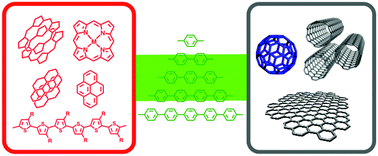当前位置:
X-MOL 学术
›
Nanoscale Horiz.
›
论文详情
Our official English website, www.x-mol.net, welcomes your
feedback! (Note: you will need to create a separate account there.)
Electron transfer and exciplex chemistry of functionalized nanocarbons: effects of electronic coupling and donor dimerization
Nanoscale Horizons ( IF 8.0 ) Pub Date : 2018-03-12 00:00:00 , DOI: 10.1039/c8nh00024g Tomokazu Umeyama 1, 2, 3, 4, 5 , Hiroshi Imahori 1, 2, 3, 4, 5
Nanoscale Horizons ( IF 8.0 ) Pub Date : 2018-03-12 00:00:00 , DOI: 10.1039/c8nh00024g Tomokazu Umeyama 1, 2, 3, 4, 5 , Hiroshi Imahori 1, 2, 3, 4, 5
Affiliation

|
In the past few decades, research on the construction of donor–bridge–acceptor linked systems capable of efficient photoinduced charge separation has fundamentally contributed to the fields of artificial photosynthesis and solar energy conversion. Specifically, the above systems are often fabricated by using carbon-based nanomaterials such as fullerenes, carbon nanotubes, and graphenes, offering limitless possibilities of tuning their optical and electronic properties. Accordingly, since understanding the structure–photodynamics relationships of π-aromatic donor–bridge–nanocarbon linked systems is crucial for extracting the full potential of nanocarbon materials, this review summarizes recent research on their photophysical properties featuring nanocarbon materials as electron acceptors. In particular, we highlight the electronic coupling effects on the photodynamics of donor–bridge–nanocarbon acceptor linked systems, together with the effects of donor dimerization. On a basis of their time-resolved spectroscopic data, the photodynamics of donor–bridge–nanocarbon acceptor linked systems is shown to be substantially influenced by the formation and decay of an exciplex state, i.e., an excited-state consisting of a π-molecular donor and a nanocarbon acceptor with partial charge-transfer character. Such basic information is essential for realizing future application of carbon-based nanomaterials in optoelectronic and energy conversion devices.
中文翻译:

功能化纳米碳的电子转移和激基化学:电子耦合和供体二聚化的影响
在过去的几十年中,对能够有效进行光致电荷分离的供体-桥-受体链接系统的构建研究,从根本上为人工光合作用和太阳能转化领域做出了贡献。具体地,通常通过使用碳基纳米材料(例如,富勒烯,碳纳米管和石墨烯)来制造上述系统,从而提供了调节其光学和电子特性的无限可能。因此,由于了解π-芳族供体-桥-纳米碳键合系统的结构-光动力学关系对于提取纳米碳材料的全部潜能至关重要,因此,本综述总结了有关以纳米碳材料为电子受体的光物理性质的最新研究。尤其是,我们重点介绍了电子耦合对施主-桥-纳米碳受体连接系统的光动力学的影响,以及施主二聚化的影响。根据他们时间分辨的光谱数据,表明供体-桥-纳米碳受体连接系统的光动力学受激基态的形成和衰减的影响很大,即,由π分子供体和具有部分电荷转移特性的纳米碳受体组成的激发态。这些基本信息对于实现碳基纳米材料在光电和能量转换设备中的未来应用至关重要。
更新日期:2018-03-12
中文翻译:

功能化纳米碳的电子转移和激基化学:电子耦合和供体二聚化的影响
在过去的几十年中,对能够有效进行光致电荷分离的供体-桥-受体链接系统的构建研究,从根本上为人工光合作用和太阳能转化领域做出了贡献。具体地,通常通过使用碳基纳米材料(例如,富勒烯,碳纳米管和石墨烯)来制造上述系统,从而提供了调节其光学和电子特性的无限可能。因此,由于了解π-芳族供体-桥-纳米碳键合系统的结构-光动力学关系对于提取纳米碳材料的全部潜能至关重要,因此,本综述总结了有关以纳米碳材料为电子受体的光物理性质的最新研究。尤其是,我们重点介绍了电子耦合对施主-桥-纳米碳受体连接系统的光动力学的影响,以及施主二聚化的影响。根据他们时间分辨的光谱数据,表明供体-桥-纳米碳受体连接系统的光动力学受激基态的形成和衰减的影响很大,即,由π分子供体和具有部分电荷转移特性的纳米碳受体组成的激发态。这些基本信息对于实现碳基纳米材料在光电和能量转换设备中的未来应用至关重要。











































 京公网安备 11010802027423号
京公网安备 11010802027423号